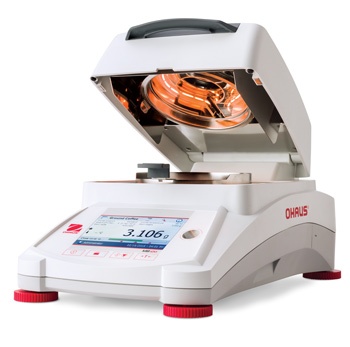The Advantages of Using Moisture Analyzers and Debunking Myths about their Usage
Quality control procedures across a broad spectrum of manufacturing, packaging, and similar operations frequently—if not always—require laboratories to include checks on the amount of moisture contained in a product. Moisture content plays an important role in products, such as pharmaceuticals, plastics, wood chips, fabrics, paint, body lotion, seeds, tobacco, potting soil, dried fruits and vegetables, catsup, and detergents.
 It is important to measure and analyze the moisture content of a substance as it impacts several dimensions, such as weight, density, refractive index, viscosity, and electrical conductivity.
It is important to measure and analyze the moisture content of a substance as it impacts several dimensions, such as weight, density, refractive index, viscosity, and electrical conductivity.
Analyzing the moisture content within a sample is typically done in an oven with a balance, a process that can take hours to complete. At Alliance Scale, we sell moisture analysis products that will complete that procedure within minutes. As a licensed distributer of OHAUS moisture analyzers, we talk about the process of moisture analysis, reasons why it is reliable, and debunk common myths surrounding its use in this blog post.
What Are Moisture Analyzers?
Thermogravimetric moisture analysis defines moisture as the loss of mass observed when a sample is heated and is based, in theory, on the vaporization of water during the drying process; this measurement does not distinguish weight loss of water from loss of volatile components or sample decomposition. Moisture analyzers measure the loss-on-drying of a material by using the change in weight from prior to heating a sample, and after heating it.
For this reason, moisture content as measured by thermogravimetric techniques includes all substances that vaporize when heating a sample, and is measured as weight loss during the heating process. The MB Series of moisture analyzers (or moisture balances) from OHAUS measure moisture thermogravimetrically. Therefore, the term “moisture content” is used, rather than “water content” when using a thermogravimetric device.
Another method of measuring moisture content is the Karl Fischer-type analyzer, which titrates KF reagent that contains iodine to sample electro-chemically. The Karl Fischer method enables a measurement from some ppm to 100% (water), but the operation is complicated, and the unit is expensive, which is why we recommend using moisture analyzers.
4 Reasons Why Moisture Analyzers Should Be Relied On
- Easy to Use
Moisture analyzers are easy to use compared to other methods, such as wet chemistry or using an oven and a balance, which could take hours because of the intricate nature of the task. Measuring moisture content in certain materials can be difficult due to the complexity of the water molecule and its strong intermolecular bonding capabilities.
- Repeatable
Moisture analyzers are repeatable, while other methods to determine moisture could lead to errors such as moisture regain after the sample is heated and weighed. Since the OHAUS moisture analyzer is one instrument, it eliminates this problem.
- Time-Efficient
Moisture analyzers are faster than most other methods of measuring moisture content. They efficiently dry a sample by transferring energy through both radiation (the transmission of energy in the form of waves or particles through a medium—in this case, the sample), and convection (heat transfer by mass motion).
A conventional drying oven, on the other hand, uses mostly convection to dry a sample. Both metal and halogen heating elements radiate energy in the infrared spectrum. The OHAUS moisture analyzers are automated systems that employ a microprocessor-controlled heating element and an analyzer all in one. By using such a device, the moisture content of a sample can be measured in minutes rather than hours.
- Flexible
Moisture analyzers are flexible enough to accommodate different materials and parameters. For instance, the OHAUS moisture analyzers have storage and multiple methods to test materials. A method is a set of parameters that defines how a sample is dried. It consists of a drying program, temperature(s), a shut-off criterion, and other parameters that define how the results are displayed (e.g., units of measure) – thereby, allowing you to determine the best method to dry a sample to produce a required result.
Debunking Some Common Myths about Moisture Analyzers
Myth: Moisture analyzers measure water content.
Truth: While some of you might believe that a loss-on-drying moisture analyzer measures the moisture content of the sample, it’s actually measuring the weight change of the sample. A moisture analyzer will measure anything that evaporates, such as oils, fats, and other similar substances.
Myth: Moisture analyzers are not precise or accurate.
Truth: The primary goal of a moisture analyzer is to be precise—so that multiple samples measured under the same conditions produce a set of results with very little variance. The user must select a method and prepare the sample in a way to ensure accuracy. When the samples are prepared the same, and the conditions and parameters are the same, accuracy and precision are automatically ensured.
Alliance Scale offers laboratory solutions that can help you effectively and efficiently assess the quality of a sample, adjust manufacturing methods, and ensure your products meet certain guidelines and regulations. To learn about our moisture analyzers and other laboratory solutions, check out our OHAUS Lab Balance Catalog.



